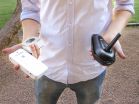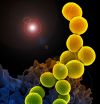(Press-News.org) The adult human body is made up of about 37 trillion cells. Microbes, mainly bacteria, outnumber body cells by 10 to 1. Increasingly, scientists recognize that this huge community of microbes, called the microbiome, affects the health, development and evolution of all multicellular organisms, including humans.
Studies show symbiotic microbes can help prevent infection by disease-causing pathogens. But sometimes the interaction goes the other way, with a pathogen or disease disrupting the normal community of symbiotic bacteria. In a new study, a team of scientists from UC Santa Barbara demonstrates that a fungal pathogen of amphibians does just that. The findings appear today in the Early Edition of the Proceedings of the National Academy of Sciences.
Landmark experiments with model organisms such as mice have shown that infectious pathogens can disrupt the "normal" microbiome, but the extent to which this process shapes symbiotic microbial communities during disease outbreaks in nature is largely unknown. This new work, conducted by Andrea Jani, a UCSB graduate student in Cherie Briggs' lab in the Department of Ecology, Evolution and Marine Biology (EEMB), addresses a fundamental gap in disease ecology and microbiome research.
Co-authors Jani and Briggs -- also affiliated with UCSB's Biomolecular Science and Engineering program -- found that the chytrid fungus Batrachochytrium dendrobatidis (Bd) appears to drive dramatic changes in symbiotic bacterial communities during natural disease episodes in four populations of the endangered Sierra Nevada yellow-legged frog (Rana sierrae). Chytridiomycosis, an emerging infectious disease of amphibian skin caused by the Bd pathogen, is a leading cause of amphibian biodiversity loss worldwide.
"In the California Sierra Nevada, this disease has led to the rapid extirpation of frogs from hundreds of high-elevation lakes; however, in other lakes, infected frogs of the same species are surviving and persisting with the fungus," explained Briggs, who is the Duncan and Suzanne Mellichamp Chair in Systems Biology. "Given that amphibian skin is the organ infected by Bd, there has been a lot of interest in how antifungal properties of some skin-associated bacteria may protect frogs against this fungal pathogen. In this study we focused on the flip side of this interaction -- that is, how infection with Bd can disrupt the skin microbial community."
"We used next-generation DNA sequencing to document significant shifts in skin-associated bacterial communities of the Sierra Nevada yellow-legged frog during natural Bd outbreaks," Jani explained. "We paired these field surveys with a laboratory infection experiment, demonstrating a causal relationship in which Bd alters the Rana sierrae microbiome."
The researchers found a remarkable consistency in the response of the microbiome to Bd infection among field populations and between the field and laboratory. Several key taxa -- a group of one or more populations of an organism or organisms -- consistently responded in the same direction to Bd infection, suggesting some predictability in the effect of Bd on the microbiome.
"What we found was that the severity of infection with Bd is strongly correlated with the composition of bacterial communities on the skin of frogs," Jani continued. "What was surprising was that across the different frog populations there was pretty striking consistency in this correlation with Bd. One of the frog populations crashed due to Bd infection; the other three populations seemed to tolerate Bd infections. So there are different disease dynamics going on, yet they have a similar relationship between the microbiome and Bd."
Still, the underlying mechanism for Bd-induced changes in the microbiome is not clear. The researchers hypothesize that the pathogen might compete directly with certain bacteria for space or resources or release compounds that negatively or positively affect certain bacterial species. Alternatively, they say, some pathogens could control immune responses of the host to favor their own growth and disrupt the normal symbiotic bacterial community.
Jani noted that some promise exists for probiotic treatments as a tool to fight the decline of frogs due to Bd, but she was careful to qualify that statement by saying that there is still a lot that scientists do not understand about either the environmental impact that might have or what the interactions are between the natural bacteria that exist on frogs and the pathogen. "We find that some taxa previously identified as having anti-Bd properties are driven to low abundances by Bd infection, which may limit their effectiveness as probiotic agents," she said.
"This study shows the importance of knowing how the many benign microbes living on and in our bodies interact with those that cause disease," said Sam Scheiner, National Science Foundation (NSF) director for the joint NSF/National Institutes of Health/United States Department of Agriculture Ecology and Evolution of Infectious Disease Program, which funded the research. "The results are important for developing responses to a disease causing amphibians to go extinct worldwide and also have implications for future studies of human health."
INFORMATION:
ANN ARBOR--In a step toward robots smaller than a grain of sand, University of Michigan researchers have shown how chains of self-assembling particles could serve as electrically activated muscles in the tiny machines.
So-called microbots would be handy in many areas, particularly medicine and manufacturing. But several challenges lie between current technologies and science fiction possibilities. Two of the big ones are building the 'bots and making them mobile.
"We are inspired by ideas of microscopic robots," said Michael Solomon, a professor of chemical engineering. ...
BUFFALO, N.Y. - Most people rarely sing publicly outside of a duty-bound rendition of "Happy Birthday." And since that particular song is usually offered as a group performance, even the reluctant join in the spirit of the occasion, hoping their individual shortcomings will be cloaked by the chorus.
"I can't sing," says the hesitant performer. But a University at Buffalo psychologist believes that most people are not as bad at singing as they might think and he is collaborating on the development of an online test that will evaluate participants' ability to match specific ...
Boulder, Colo. -- Nov. 10, 2014 -- When the double asteroid Patroclus-Menoetius passed directly in front of a star on the night of Oct. 20, a team of volunteer astronomers across the U.S. was waiting.
Observing the event, known as an occultation, from multiple sites where each observer recorded the precise time the star was obscured, yielded the first accurate determination of the two objects' size and shape. The analysis was led by Dr. Marc W. Buie, staff scientist in Southwest Research Institute's (SwRI) Space Studies Department in Boulder, Colo.
The team effort was ...
Scientists at the University of Arizona have discovered what might be the closest thing to "baby photos" of our solar system. A young star called HD 95086 is found to have two dust belts, analogous to the asteroid and Kuiper belts in the Solar System, surrounded by a large dust halo that only young planetary systems have.
Similar dust structures are also found around another, slightly older star called HR 8799, where four massive planets occupy the large gap between the two belts. HR 8799, the first star found to host four directly imaged planets, is often referred ...
A new class of apps and wireless devices used by private pilots during flights for everything from GPS information to data about nearby aircraft is vulnerable to a wide range of security attacks, which in some scenarios could lead to catastrophic outcomes, according to computer scientists at the University of California, San Diego and Johns Hopkins University. They presented their findings Nov. 5 at the 21st ACM Conference on Computer and Communications Security in Scottsdale, Ariz.
`
Researchers examined three combinations of devices and apps most commonly used by private ...
Regulation of a single, specific gene in a brain region related to drug addiction and depression is sufficient to reduce drug and stress responses, according to a study conducted at the Icahn School of Medicine at Mount Sinai and published October 27 online in the journal Nature Neuroscience.
The Mount Sinai study focuses on epigenetics, the study of changes in the action of human genes caused, not by changes in DNA code we inherit from our parents, but instead by molecules that regulate when, where and to what degree our genetic material is activated.
Previous research ...
System 05B degenerated into a remnant low pressure area on Nov. 8 and lingered near the east-central coast of India for two days before dissipating on Nov. 10.
The tropical cyclone's western edge spread over land on Sunday, Nov. 9 while the center of the low-level circulation remained over open waters of the Bay of Bengal. On that day, 05B's remnants were centered near 14.0 north latitude and 83.8 east longitude, about 215 miles east-northeast of Chennai, India.
Infrared imagery from satellites on Nov. 9 indicated that the low-level circulation center of the storm was ...
URBANA, Ill. - Dating couples who have moved toward marriage over the course of their relationship remember accurately what was going on at each stage of their deepening commitment. But couples whose commitment to each other has stagnated or regressed are far less accurate in their memories of their relationships, says a new University of Illinois study.
"People like to feel that they're making progress as a couple. If they're not--if, in fact, the relationship is in trouble--they may have distorted recollections that help them feel like they're moving forward because ...
PORTLAND, Ore. - Use of "antibiograms" in skilled nursing facilities could improve antibiotic effectiveness and help address problems with antibiotic resistance that are becoming a national crisis, researchers conclude in a new study.
Antibiograms are tools that aid health care practitioners in prescribing antibiotics in local populations, such as a hospital, nursing home or the community. They are based on information from microbiology laboratory tests and provide information on how likely a certain antibiotic is to effectively treat a particular infection.
The recent ...
Alexandria, Va. -- On March 13, 1989, a geomagnetic storm spawned by a solar outburst struck Earth, triggering instabilities in the electric-power grid that serves much of eastern Canada and the U.S. The storm led to blackouts for more than 6 million customers and caused tens of millions of dollars in damages and economic losses. More than 25 years later, the possibility of another such catastrophe still looms, and the day-to-day effects of space weather on electrical systems remain difficult to quantify. Now, a new study correlating electrical insurance claims with geomagnetic ...






